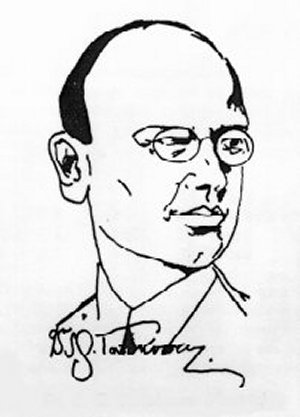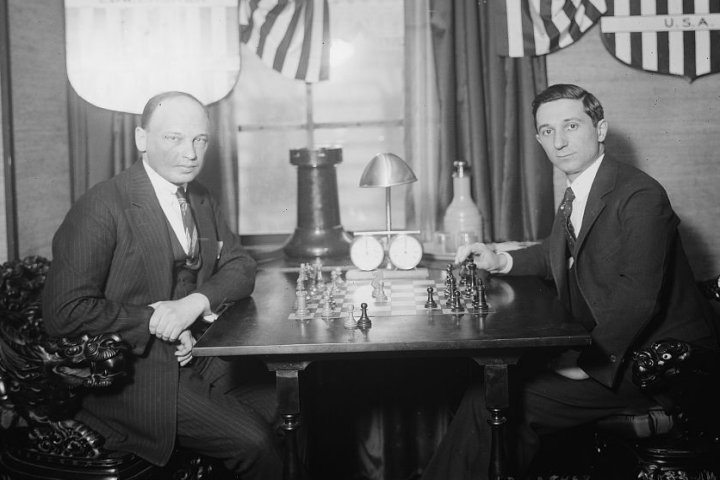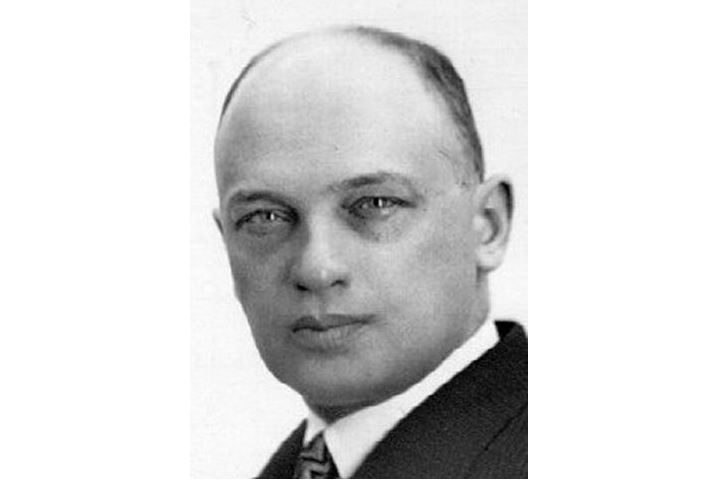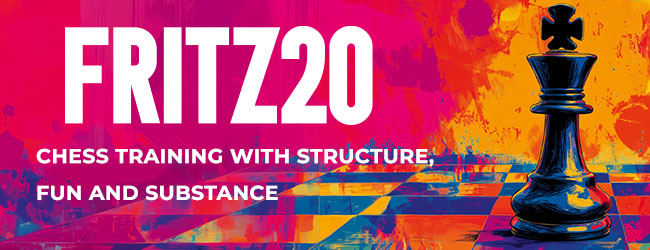Savielly Tartakower was born in Rostov-on-Don, Russia on February 21, 1887, to Austro-Hungarian parents. A few years after his birth, the family returned to Vienna.
Tartakower spent his youth mainly in Vienna, which was then one of Europe’s outstanding cultural capitals. Chess also happened to thrive there as it was home to some of Europe’s strongest masters, namely Carl Schlechter, Geza Maroczy, Richard Reti, and Milan Vidmar. While studying law, Tartakower came to love chess and soon split time between his studies and competitions. He scored his first significant achievement when he won Nuremberg 1906, becoming, at nineteen, an acknowledged master.
The victory earned him invitations to prestigious competitions, and a professional chess career must have already been in the offing. World War I, however, derailed him. When it ended in 1918, he found the Austro-Hungarian Empire dissolved, and himself an emigrant in France. Then stateless, he chose Polish citizenship. In France, he decided to turn professional.
Thus began his long and illustrious career. In his heyday, he would find himself in the thick of tournament play against the veritable who’s who of the first half of 20th century chess. He won some and finished in the top half of the majority of them. His most significant successes include winning Vienna 1923, Hastings 1926-1927 and 1927-1928, and Liege 1930. He was also a fixture of the "super tournaments” of the day, performing creditably in St. Petersburg 1909, New York 1924, San Remo 1930, and Groningen 1946.

Drawing of Tartakower (Archive G. Jacoby)
Twice the national champion of Poland (1935 and 1937), he teamed up with Akiba Rubinstein to win the Olympiad gold in Hamburg 1930. He later acquired French citizenship, and also became France’s national champion in 1953.
His prime years happened to be dominated by the legendary trio of Emanuel Lasker, Jose Raul Capablanca, and Alexander Alekhine. Tartakower was somewhat often pushed off the limelight, but there was never any doubt about his caliber and quality as a player. He scored victories against Lasker and Alekhine and every other great contemporary. Only Capablanca proved too formidable for him, and he lost five games to the Cuban without winning one. Their matches, however, were all hard struggles. In New York 1924, for instance, Capablanca had to labor mightily to eke out an endgame victory. Such perfect play was forced out of Capablanca that the game has become a staple of rook and pawn endgame books.
Yet, there must be something more to a man of such lofty estimation than just his trail of practical successes. What really made Tartakower great? What was the significance of his time in chess from 1905 to 1954? Well, quite simply, fifty years was long enough for him to prove his many facets, and he established convincingly that he was equally great as a thinker, theoretician, writer and analyst. Each of these qualities deserve a closer look.
Tartakower as a Thinker and Theoretician
Tartakower was a natural child of the Classical Age, as when he started competing seriously in 1905, Wilhelm Steinitz’s positional principles were already well understood and assimilated. When Aaron Nimzowitsch and Richard Reti blazed new trials with their Hypermodern play in the 1920s, Tartakower was among the first to take notice. He tested their new ideas and demonstrated that space and the center could be surrendered in the opening provided counter play came vigorously. This discovery was very timely, as just when some leading masters thought that chess had all been played out, it was really richer and more complex than it was. Nimzowitsch, Reti, and Tartakower opened a new frontier for exploration and study, with the result that chess reached unprecedented dynamism by the time the Soviets dominated the scene in the 1940s.

Savielly Tartakower vs Eduard Lasker, New York 1924 | Photo: Wikipedia
Tartakower’s love for ideas extended to specific lines in the opening, the most significant of which is the Tartakower Variation of the Queen’s Gambit Declined. In this variation, Black accepts structural defects for dynamic compensation, leading to a rich game that Tartakower so relished. It has been a mainstay of top level chess, with the chances of both sides having been contested thoroughly by no less than Garry Kasparov and Anatoly Karpov in their 1985 and 1987 World Championship matches.
Perhaps not very many know that it was also Tartakower who introduced the Catalan Opening. In Barcelona 1929, organizers asked Tartakower to develop an opening in honor of the host city, and true to his chess ethos, his creation combined the classical (1. d4) with the hypermodern (g3). It is one of the best openings to play if you wish to gain an advantage against 1...d5 by subtler means, and has been a recent weapon of Magnus Carlsen.
Other openings he introduced, although to lesser fanfare, are the Tartakower Variation of the Caro-Kann and the Dutch Defense. Last on this list is the Orangutan Opening with 1. b4, but this one is too extreme to really gain mainstream acceptance.
Tartakower was a man fascinated by ideas. His search for their underlying truths, coupled with his practical successes, helped propel chess to a new era.
Tartakower as a Writer and Analyst
While battling over the board, Tartakower also worked as a journalist. He would send tournament reports to newspapers and magazines, and writing became much his craft that, in time, he produced his magnum opera, My Best Games of Chess 1905-1954 and The Hypermodern Game of Chess.

These books, while a bit flowery, are models of annotation. Tartakower’s ability to combine variations at a manageable depth and discuss strategy tersely makes them two of the finest instructional materials.
Tartakower, along with Alekhine, set the standards for quality annotation, and his two books are still relevant today as they illustrate the level of accuracy, tactical proficiency, and depth of strategic understanding required to play the game at a fairly high level.
These books also don’t lack for entertainment. For one, they present the evolution of Tartakower’s playing style as he incorporated Hypermodernism, and his games as a mature competitor exemplify the delectably rich and complex Tartakower games we know. For another, they contain what really made Tartakower inimitable – his aphorisms.
Better known as Tartakowerisms, Tartakower’s aphorisms capture humorously some truths and experiences of chess life. They reveal Tartakower as an intelligent, perceptive, and highly educated fellow who happened to play chess. Here are some of the popular ones.
"The winner of the game is the player who makes the next-to-last mistake."
"I never defeated a healthy opponent."
"Tactics is what you do when there is something to do; strategy is what you do when there is nothing to do."
"A match demonstrates less than a tournament. But a tournament demonstrates nothing at all."
Tartakower’s games, ideas, writings, and contributions to the development of chess are his lasting legacies that we all should appreciate.
Tartakower's Immortal
This game should be familiar to dedicated players, but on this occasion what better to present than Tartakower’s absolute gem? It is to Tartakower what Adolf Anderssen’s The Immortal and The Evergreen Games are, and games like these never stale.
This game ought to have won the tournament’s brilliancy prize but, oddly, the judges deemed Tartakower’s attack to be too deep and incalculable to deserve it. Aren’t real sacrifices speculative?
| Replay and check the LiveBook here |
Please, wait...
1.d4 e6 2.c4 f5 3.Nc3 Nf6 4.a3 Be7 5.e3 0-0 6.Bd3 d5 7.Nf3 c6 8.0-0 Ne4 9.Qc2 Bd6 10.b3 Nd7 11.Bb2 Rf6 12.Rfe1 Rh6 13.g3 Qf6 14.Bf1 g5 15.Rad1 g4 16.Nxe4 fxe4 17.Nd2 Rxh2 18.Kxh2 Qxf2+ 19.Kh1 19.Bg2 Nf6 20.Qc3 Qxg3+ 21.Kg1 Qh2+ 22.Kf1 Nh5 23.Nxe4 dxe4 24.d5 e5 25.dxc6 Ng3+ 26.Kf2 Be6 19...Nf6 19...Qxg3 20.Nb1 20.Re2 Qxg3 21.Nb1 Nh5 22.Qd2 Bd7 23.Rf2 23.Qe1 Qf3+ 24.Rg2 Qh3+ 25.Kg1 Rf8 26.Nd2 Bg3 27.Rxg3 Qxg3+ 28.Qxg3 Nxg3 29.Bc3 Nf5 30.Re1 h5 23...Qh4+ 24.Kg1 Bg3 25.Bc3 25.Rg2 Rf8 26.Qe2 Rf3 27.Bc3 Bd6 28.Be1 g3 29.Nd2 Qg4 25.Rh2 Bxh2+ 26.Qxh2 Qg5 27.Bc1 g3 28.Qh1 Kh8 29.Be2 Nf6 30.Rf1 Rg8 31.Rf4 e5 32.dxe5 Qxe5 33.Qh4 Rg6 34.Bd2 d4 35.exd4 Qxd4+ 25...Bxf2+ 26.Qxf2 g3 27.Qg2 Rf8 28.Be1 Rxf1+ 29.Kxf1 e5 30.Kg1 30.Bxg3 Nxg3+ 31.Kf2 Bg4 32.Re1 Ne2+ 33.Kf1 Kh8 30.Ke2 Bg4+ 31.Kd2 Qh2 32.Qxh2 gxh2 30...Bg4 31.Bxg3 31.Rd2 exd4 32.exd4 Bf3 33.Bxg3 Nxg3 34.Qh2 Qxh2+ 35.Rxh2 Ne2+ 36.Kf2 Nxd4 31...Nxg3 32.Re1 Nf5 33.Qf2 Qg5 34.dxe5 34.Kf1 Qh5 35.Qg1 Qh4 36.Nc3 Ng3+ 37.Kg2 Nh1 38.Kf1 Qf6+ 34...Bf3+ 35.Kf1 Ng3+ 0–1
- Start an analysis engine:
- Try maximizing the board:
- Use the four cursor keys to replay the game. Make moves to analyse yourself.
- Press Ctrl-B to rotate the board.
- Drag the split bars between window panes.
- Download&Clip PGN/GIF/FEN/QR Codes. Share the game.
- Games viewed here will automatically be stored in your cloud clipboard (if you are logged in). Use the cloud clipboard also in ChessBase.
- Create an account to access the games cloud.
| Maroczy Geza (HUN) | - | Tartakower Savielly (FRA) | - | 0–1 | 1922 | A85 | It | |
Please, wait...
Links
More about Tartakower...


























